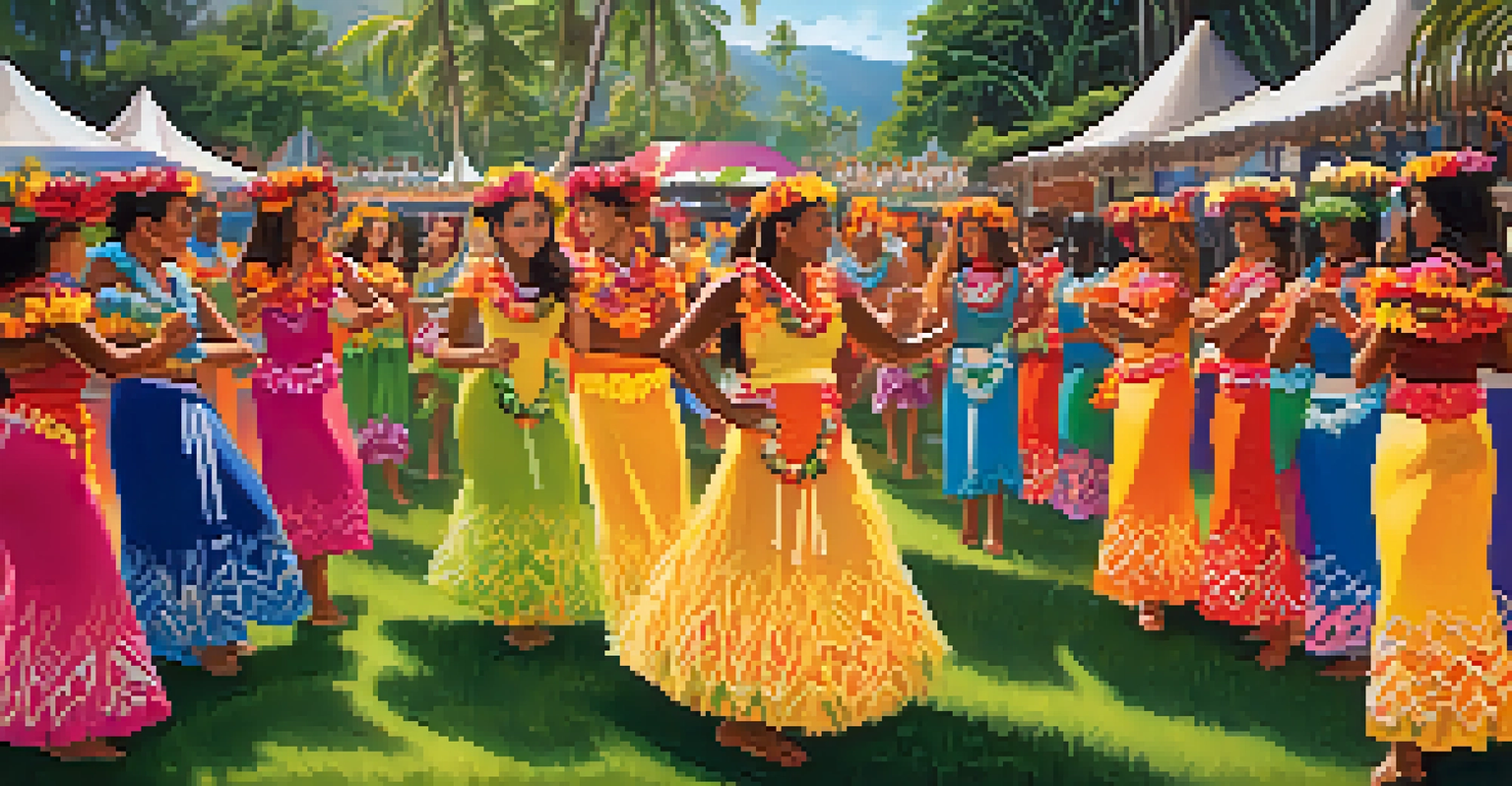Tourism in Hawaii: Historical Roots and Modern Impact

The Early Beginnings of Tourism in Hawaii
Tourism in Hawaii has roots that trace back to the early 19th century when European explorers and American missionaries arrived. This marked the beginning of a new era for the islands, as visitors became fascinated by the local culture, natural beauty, and unique traditions of the Hawaiian people. The arrival of steamships further opened the islands to the outside world, making travel more accessible.
The world is a book and those who do not travel read only one page.
By the late 1800s, Hawaii began to see an influx of wealthy tourists seeking relaxation and adventure. The establishment of hotels and the development of infrastructure catered to these visitors, setting the stage for what would become a booming tourism industry. This early tourism laid the groundwork for Hawaii's transformation into a premier vacation destination.
However, this influx also led to significant changes for the local population. As tourism grew, it brought both economic opportunities and challenges, altering traditional lifestyles and cultural practices. Understanding these historical roots is essential to grasp the full impact of tourism on Hawaii today.
Cultural Exchanges: Tourism's Role in Hawaii
Tourism has facilitated a rich cultural exchange between the Hawaiian people and visitors from around the globe. This interaction often leads to a deeper appreciation for Hawaiian customs, music, hula, and the spirit of 'Aloha'. Many tourists leave with a newfound respect for Hawaiian culture, fostering a sense of connection that transcends geographical boundaries.

However, this cultural exchange is a double-edged sword. While it promotes understanding and appreciation, it can also lead to the commercialization of culture. Traditional practices might be altered or performed for tourists' entertainment, which sometimes dilutes their original meaning and significance.
Tourism's Economic Importance
Tourism is a vital part of Hawaii's economy, providing jobs and generating significant revenue while also posing challenges related to economic dependence.
Despite these challenges, many Hawaiians work to preserve and share their culture authentically. Community events, cultural festivals, and educational programs aim to educate visitors about the true essence of Hawaiian life, ensuring that the spirit of the islands remains intact amid the tourism boom.
Economic Impact of Tourism in Hawaii
Tourism is a cornerstone of Hawaii's economy, providing thousands of jobs and generating significant revenue. The industry supports various sectors, from hospitality to agriculture, and it plays a critical role in sustaining local businesses. This economic boost has allowed for infrastructure improvements and community development across the islands.
Tourism is a vital part of Hawaii's economy, but it must be balanced with the needs and values of the local community.
However, reliance on tourism can also make Hawaii vulnerable to economic fluctuations. Events such as natural disasters or global crises—like the COVID-19 pandemic—can severely impact visitor numbers, leading to economic downturns. This dependency raises questions about sustainable economic practices and the need for diversification.
To address these challenges, many Hawaiian leaders are advocating for responsible tourism. This approach encourages visitors to engage with local communities and support small businesses, creating a more balanced economic ecosystem that benefits both residents and travelers alike.
Environmental Considerations in Tourism
Hawaii's stunning landscapes and diverse ecosystems attract millions of visitors each year, but this popularity comes with environmental costs. Overcrowding in popular areas can lead to habitat destruction, pollution, and strain on natural resources. Preserving the islands’ unique environment while accommodating tourists is a critical challenge for local authorities.
Efforts to promote sustainable tourism practices are gaining traction, focusing on minimizing ecological footprints. Initiatives such as encouraging responsible hiking, beach clean-ups, and conservation activities aim to educate visitors on the importance of protecting Hawaii's natural beauty. These practices not only benefit the environment but also enrich the visitor experience.
Cultural Exchange and Preservation
While tourism fosters cultural exchange and appreciation, it also risks commercializing Hawaiian traditions, prompting efforts to preserve authentic practices.
Additionally, local organizations are working hard to restore and protect native ecosystems. By engaging tourists in conservation efforts, they foster a sense of stewardship, encouraging visitors to leave Hawaii as beautiful as they found it. This collaborative approach highlights the importance of balancing tourism with environmental preservation.
The Evolution of Hawaiian Tourism Marketing
Hawaii's tourism marketing has evolved significantly since the early days of travel brochures and print ads. Today, digital marketing strategies dominate, utilizing social media and influencer partnerships to reach potential visitors. This shift allows for more dynamic storytelling, showcasing the islands' beauty and culture in real-time.
In this digital age, the concept of 'experiential travel' has gained popularity, with tourists seeking authentic experiences rather than just typical sightseeing. Hawaii's marketing efforts now emphasize immersive cultural experiences, adventure tourism, and wellness retreats, attracting a diverse range of travelers. This evolution reflects changing consumer preferences and a growing desire for meaningful connections.
However, this shift also brings challenges in ensuring that marketing efforts remain authentic and respectful of Hawaiian culture. Striking a balance between promoting the islands and maintaining cultural integrity is crucial for sustainable tourism. As Hawaii continues to adapt its marketing strategies, the focus remains on celebrating the islands’ uniqueness while inviting the world to explore.
Challenges Facing Hawaii's Tourism Industry
Despite its allure, Hawaii's tourism industry faces numerous challenges that require attention. Issues such as overcrowding, rising costs of living, and the impacts of climate change threaten both the environment and local communities. Balancing the needs of tourists with those of residents is crucial for the future sustainability of the industry.
Local leaders and policymakers are working to address these challenges through various initiatives. Efforts to manage tourist numbers, promote off-the-beaten-path destinations, and encourage longer stays are being explored. These strategies aim to distribute the economic benefits of tourism more evenly across the islands, reducing pressure on popular hotspots.
Sustainable Tourism Initiatives
The future of Hawaii's tourism relies on sustainable practices and community collaboration, ensuring that both visitors and residents benefit from tourism.
Moreover, the ongoing discussion about the effects of tourism on Hawaiian culture and identity remains vital. By prioritizing community input and fostering collaboration, Hawaii's tourism industry can evolve to better serve both visitors and residents alike, creating a more harmonious relationship between the two.
The Future of Tourism in Hawaii
Looking ahead, the future of tourism in Hawaii is poised for transformation. As travelers increasingly prioritize sustainability, wellness, and authentic experiences, the islands must adapt to meet these demands. This shift could lead to a more balanced approach to tourism that benefits both visitors and the local population.
Innovative initiatives are already underway, focusing on eco-friendly accommodations, farm-to-table dining, and community-based tourism. These efforts not only promote sustainable practices but also ensure that tourism revenue supports local businesses and preserves Hawaiian culture. By prioritizing these values, Hawaii can set a positive example for other tourist destinations.

Ultimately, the future of tourism in Hawaii hinges on collaboration among stakeholders, including local communities, government agencies, and the tourism industry. By working together to create a sustainable tourism model, Hawaii can continue to be a beloved destination while honoring its rich cultural heritage and natural beauty.